Key Takeaways:
- Hygiene and Cleanliness: Toilet training cats can significantly reduce the mess and odor associated with traditional litter boxes.
- Environmental Impact: Switching from kitty litter to toilet training can lessen the environmental burden caused by the mining and disposal of cat litter.
- Health Benefits: Reducing the risk of diseases spread through cat feces benefits both the cat and its human companions.
Toilet training cats might sound like a circus act, but it's a real practice with genuine benefits. If you've ever dreaded the daily scoop of the litter box, then cat toilet training might just be the next skill you want to teach your feline friend. Let's dive into the quirky yet practical world of teaching Fluffy to use the toilet.
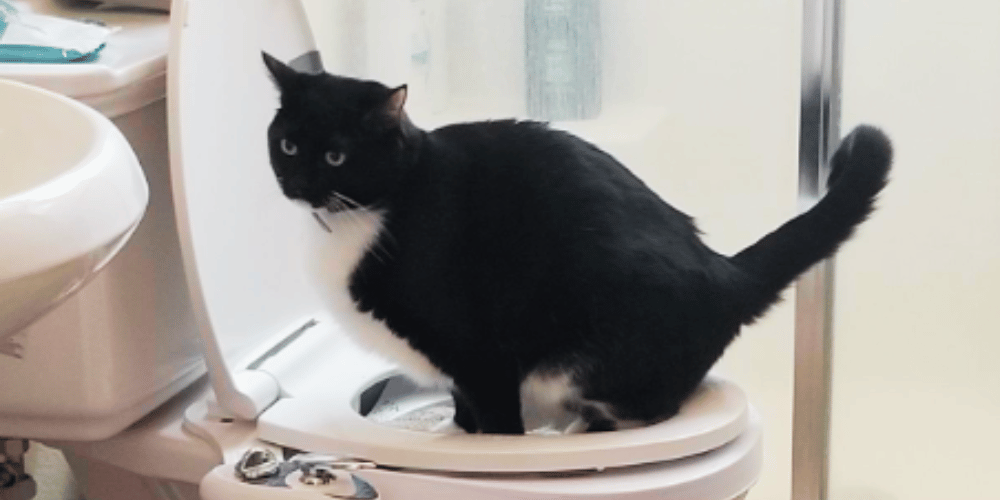
The Scoop on Cat Toilet Training
Imagine a world where you never have to buy, carry, or scoop kitty litter again. Sounds pretty purr-fect, right? Toilet training your cat isn't just a fantasy. It's a feasible alternative to the traditional litter box that many cat owners are embracing. By training your cat to use the toilet, you eliminate the need for cat litter, which not only saves you time and effort but also reduces household waste.
A Cleaner, Fresher Home
Nobody likes the smell of a dirty litter box. By toilet training your cat, you can say goodbye to the stench of cat urine and feces that often permeates the air around traditional litter boxes. This means a fresher, cleaner smelling home, which is especially important in smaller living spaces where odors are more confined. Plus, you won't find stray litter granules sticking to your socks anymore!
Environmental Paws-itive
Traditional cat litter isn't just a hassle to deal with; it also has a significant environmental impact. Most clumping kitty litters are made from bentonite clay, which is obtained through strip mining. By toilet training your cat, you contribute to reducing the demand for strip-mined materials, thus lessening your ecological footprint. It's a small step for a cat, but a giant leap for mankind!
Health Benefits Galore
Toilet training your cat can lead to better health for both your pet and your family. Litter boxes can harbor bacteria and a nasty parasite called Toxoplasma gondii, which can be especially dangerous for pregnant women and immunocompromised individuals. By eliminating the litter box, you reduce the risk of these health hazards becoming a problem in your home.
Space Savers Unite
If you're living in an apartment or a smaller house, you know that every inch of space counts. Ditching the litter box frees up space in your home. No more dedicating a corner of your bathroom or laundry room to your cat's waste. This can be particularly beneficial in homes where space is at a premium.
The Comedic Side of Cat Toilet Training
Have you ever walked into the bathroom only to find your furry friend perched majestically on the toilet seat? Yes, toilet training your cat can lead to some hilarious household scenes. Imagine the surprise on your guests' faces when they see your cat casually using the toilet bowl like it's the most natural thing in the world. This isn't just a party trick; it's a practical solution that can save you from the never-ending battle of the litter pan. Plus, it's a small price to pay for never stepping on scattered cat litter again!
But let's not forget the moments of sheer comedy gold when toilet training doesn't go as planned. Picture this: your cat, determined to master the art of the toilet, accidentally flips the toilet lid mid-business, resulting in a cat-and-water spectacle that's sure to leave everyone in stitches. While these mishaps can be messy, they're also memorable moments that highlight the quirky and unpredictable nature of our feline friends. Just remember, not all cats will be toilet training prodigies, and that's perfectly okay!
The Unexpected Social Life of a Toilet-Trained Cat
Have you ever imagined your cat being the life of the party? Well, toilet training your cat might just give it that extra flair! Picture this: guests are over, and while they're expecting maybe a trick or two, your cat casually strolls into the bathroom, hops up onto the toilet, and takes care of business. Minds? Blown. This party trick not only serves as a great icebreaker but also showcases your cat's unique skills, making it the center of attention and possibly the next viral sensation on social media.
But it's not just about the fame. Toilet training your cat can significantly alter its social interactions with other pets and humans. Cats are naturally territorial, and removing the cat's litter box can reduce the scent markers that define their territory. This might lead to a more harmonious household, as there are fewer 'claimed' areas, which can sometimes be a source of conflict among pets. Plus, your guests will likely appreciate the lack of a litter box smell, making their visit more enjoyable and less of a nasal adventure.
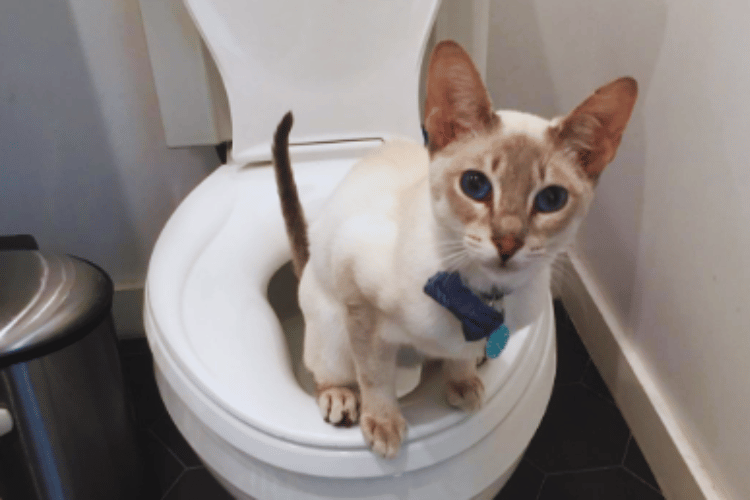
The Art of Camouflage: When Your Cat's Litter Box Disappears
Have you ever wondered what happens when a cat's litter box magically transforms into a regular human toilet? Well, it's quite the spectacle! Imagine your furry friend, who once kicked sand like a tiny bulldozer, now perching elegantly on the porcelain throne. This shift not only frees up more space in your home but also taps into the cat's natural instincts to cover their tracks. It's like a stealth mission where the target is to hide all evidence of cat's poop, making your bathroom floor look like a pristine, uncharted territory.
But here's the kicker: while your cat masters the art of toilet camouflage, you might find yourself questioning your own bathroom habits. Suddenly, the roles are reversed, and you're the one learning about precision and patience. Toilet training your cat isn't just about teaching them new tricks; it's about harmonizing your daily routines in such a way that you both feel like secret agents in a spy movie. Plus, think of all the hilarious stories you'll have for dinner parties about your cat's undercover bathroom escapades!
The Secret Life of Cat's Litter Box: Mysteries Unveiled
Ever wondered what tales a cat's litter box could tell if it had the power of speech? Well, brace yourself for some giggles and gasps! The cat's litter box isn't just a simple container; it's the epicenter of your furry friend's natural instincts. It's where all the magic happens – from burying their treasures to marking their territory. This hidden gem in your home is a treasure trove of secrets about your cat's health and habits. Observing how your cat uses the litter box can give you early signs of health issues, like kidney problems or the development of arthritis, which might otherwise go unnoticed.
But here's the kicker – when you transition to a toilet trained cat, this box of secrets disappears! What happens then? Well, toilet training forces you to become a bit of a detective. You'll need to stay sharp to catch those subtle signs of distress or illness, previously spelled out in the litter box. No more sifting through sand for clues; you'll need to learn new ways to keep tabs on your cat's health. It's like swapping a mystery novel for a spy thriller!
The Great Throne Debate: Is the Toilet Really Better than the Litter Box?
When it comes to deciding between a traditional cat's litter box and the majestic human throne, the debate can get as heated as a furball in the sun! On one paw, using the toilet can make a cat feel like royalty—no more digging through sandy grains. On the other paw, some argue that a cat's natural instincts are stifled when they can't perform the age-old ritual of covering their tracks. It's a clash of convenience versus instinct, and let's be honest, watching a cat ponder over this can be quite the comedy show!
Moreover, transitioning from a litter box to a toilet might seem like a small step for a cat, but it's a giant leap for cat-kind. Imagine the scenario: a cat walks into the bathroom, tail high with confidence, only to find that its usual sandy pit has transformed into a shiny porcelain bowl. The first few attempts can be a mix of hilarious acrobatics and confused stares. While some feline adventurers take to it like a cat to catnip, others might look at their humans as if they've just rewritten the laws of physics!
The Litter-ary Genius: How Cats' Natural Instincts Influence Toilet Training
Cats are not just fluffy bundles of cuteness; they're also surprisingly clever, especially when it comes to their bathroom habits. Thanks to their natural instincts, cats usually take to toilet training with a curiosity that would make even the most seasoned librarian envious. Imagine your cat, perched on the porcelain, pondering the mysteries of flushing. This isn't just a party trick; it's a testament to their adaptability and intelligence. By tapping into these instincts, you're not just teaching them a new skill but also engaging with their innate litter box wisdom.
However, it's not all smooth sailing. Sometimes, these natural instincts can lead to hilarious scenarios. Picture this: your cat, having mastered the art of toilet use, decides that the sink or perhaps your neighbor's unattended laundry basket is the next frontier. Cats' natural instincts to cover their waste can lead them to some pretty creative conclusions. While it's essential to be patient and keep a sense of humor, it's also a good opportunity to marvel at just how deeply ingrained these behaviors are in your cat's psyche.
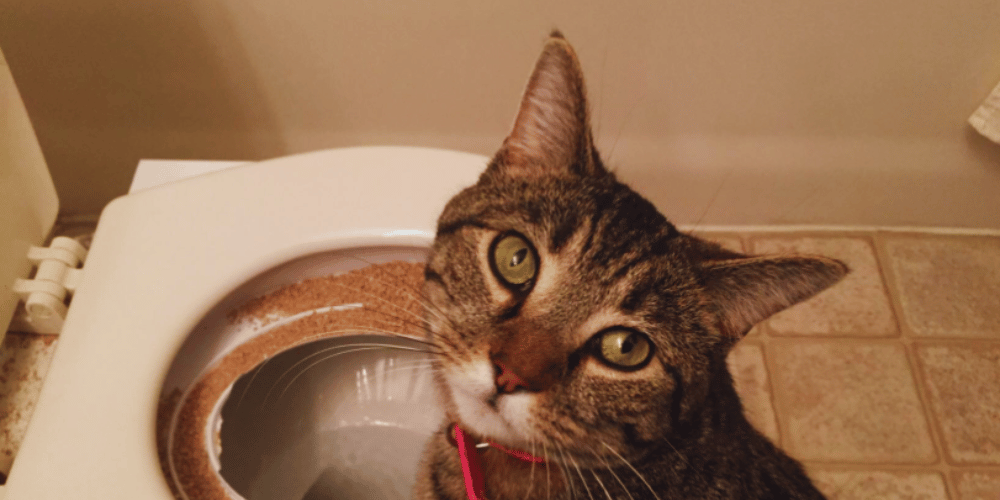
The Litter Box Vanishing Act: A Magician's Guide to Cat Toilet Training
Have you ever wondered where the cat's litter box disappears to during the magic of toilet training? It's like a magician's best-kept secret, only the wand is a paw! Transitioning from the litter box to the toilet can seem like a sleight of hand to the untrained eye. One day there's a box full of cat's waste, and the next, poof! It's just your cat perched on the porcelain throne, looking as regal as ever. This disappearing act not only cleans up the appearance of your home but also reduces the daily chore of litter box maintenance.
But let's not forget the comedic gold that comes with the initial phases of this transition. Picture this: a cat, puzzled by the sudden elevation in its bathroom routine, accidentally leaves a trail of cat's litter outside the bathroom. It's like Hansel and Gretel, only it's Fluffy trying to find her way back to the familiar territory of her litter box. These moments, while amusing, are pivotal in understanding your cat's natural instincts and helping them adapt smoothly to their new bathroom regime.
The Potty Plot: Uncovering the Secrets of Cat's Waste Management
Ever wondered what goes on in the mind of your feline friend when it's time to hit the bathroom? Well, it's quite the potty plot! Cats are naturally clean animals, and their instincts drive them to cover up their waste. This behavior is not just about being tidy; it's a survival tactic to hide their presence from predators and other threats. When you switch from a cat's litter box to a toilet, you might just be turning them into the James Bond of the animal kingdom—sleek, smart, and masters of disguise!
However, transitioning to this new 'throne' can be a bit of a puzzle for your furry detective. Cats' natural instincts tell them to dig and cover their tracks, literally. When the litter box disappears, and a shiny porcelain bowl appears, it's like a plot twist in their daily routine. Observing how your cat adapts, or doesn’t, can be quite the comedy. Some might stare bewildered at the water, while others might take to it like a fish to water—each cat's reaction is a unique unraveling of their potty plot!
The Loo Chronicles: A Tale of Cat's Health and Hygiene
When it comes to cat's health, the type of potty they use can play a surprisingly pivotal role. Who knew that a cat's litter box could be akin to a personal health diary? By monitoring your cat’s poop and urine in a traditional litter box, you can keep tabs on their well-being. Changes in waste can indicate health issues ranging from minor to severe. The switch to toilet training means you might miss these signs, so it’s like losing a chapter in the ongoing health chronicle of your feline friend.
Yet, there's a flip side to this tale. Using the toilet can enhance a cat's hygiene and reduce their exposure to potentially harmful bacteria that can lurk in litter boxes. No more tiny grains stuck on furry paws or the dreaded task of cleaning the box itself. Plus, flushing away cat's waste immediately can make your home a fresher scene—no more odors wafting from the corner! It's a cleaner chapter in your cat's loo chronicles, but one that requires careful consideration and vigilance for the sake of their health.
The Royal Flush: How Cats Maintain Their Dignity and Hygiene
In the regal world of cats, maintaining dignity is paramount, and what better way to uphold this than by mastering the art of using the human toilet? Cats are known for their cleanliness, and by eliminating the need for a litter box, they take their hygiene to a whole new level. No more cat's poop or cat's urine in open sight; everything goes directly down the drain. This not only keeps their fur cleaner but also reduces the risk of diseases associated with lingering waste.
However, as cats grow older, some may develop arthritis, making it challenging to hop onto the higher surfaces like a toilet. It's essential to monitor your cat's health and mobility, ensuring their comfort throughout their toilet training journey. If you notice any hesitation or discomfort, it might be time to reconsider if this regal bathroom upgrade is suitable for your furry monarch. After all, the goal is to enhance their well-being, not to add stress to their royal duties.
The Pee-rs and Poops of Aristocracy: Cat's Health and Hygiene Royalty
When it comes to the royal treatment, cats take the crown, especially concerning their health and hygiene. Toilet training your cat isn't just about avoiding the stink; it's about elevating their health status to that of hygiene royalty. By transitioning from cat's litter box to toilet, you reduce the risk of them coming into contact with their own waste, which can harbor bacteria and parasites. This means a lower chance of urinary tract infections and, for older cats, a lesser risk of developing arthritis from digging through litter.
And let's not forget the comedic gold that comes with watching your cat navigate their new throne. There's something inherently funny about a dignified feline handling their business on human porcelain. But beyond the laughs, there's a serious point: monitoring your cat's poop and urine can be crucial in catching health issues early. Regular toilet trips can help you keep an eye on your cat's waste, ensuring they remain the picture of health and cleanliness. After all, isn't that what every member of feline aristocracy deserves?
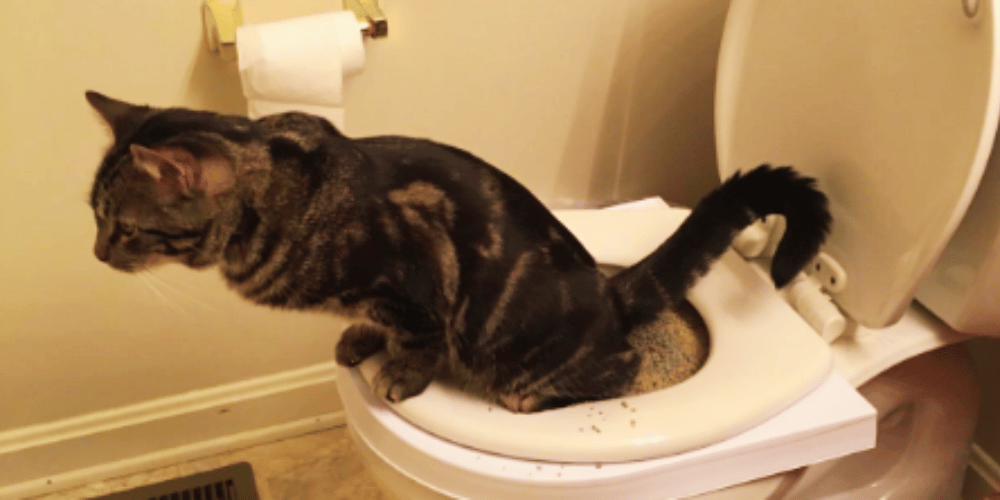
Purr-plexing Potty: When Cats Bring Their Friends
Have you ever heard of a potty party? Well, it seems some toilet-trained cats might be trendsetters in this new social gathering. Picture this: one fine morning, you stroll into your bathroom only to find not just your cat, but a couple of their furry friends lined up for a turn at the toilet. It turns out, cats might share more than just whisker-twitching gossip; they could be sharing potty training tips too! This unexpected turn of events adds a whole host of questions about privacy, etiquette, and just how many cats can fit in a bathroom before it becomes a fur-nado.
This feline social gathering could also stir up some jealousy among other cats who are still using the traditional litter box. Imagine the mixed feelings of a cat as it watches its buddy leap onto the toilet with grace and precision. Could this lead to a revolution in potty training, or a rebellion of the litter users? Only time will tell, but one thing is for sure—cat owners might need to start thinking about setting up a bathroom schedule to avoid early morning traffic jams!
When Cats Outsmart Their Owners: Toilet Training Edition
Think you're the smartest being in your household? Wait till you see a toilet trained cat in action! These feline geniuses take toilet training to a whole new level. Imagine walking into your bathroom only to find your cat perched on the throne like it owns the place. It's not just about the novelty; it's a full display of a cat's adaptability and intelligence. Toilet training taps into a cat's natural instincts to cover their waste, and it's fascinating to see how they manage without a speck of sand in sight.
However, this intelligence can sometimes be a double-edged sword. A toilet trained cat might decide that the toilet water is a new plaything or worse, a place to drop toys (or other unexpected items). This can lead to some hilarious but potentially messy situations. Every cat owner needs to be prepared for a bit of mischief. After all, sharing your bathroom with a cat means entering into an unspoken agreement where you might occasionally have to fish out something other than cat's poop from the toilet!
The Ripple Effect: How Toilet Training Your Cat Affects Local Wildlife
When you decide to toilet train your cat, you're not just signing up for a cleaner home; you're also stepping into a role as an environmental hero. Here's the scoop: traditional cat litter can be quite harmful to water dwelling wildlife when not disposed of properly. By switching to the toilet, your cat's waste goes directly into the sewage system, bypassing the great outdoors entirely. This means fewer chances of harmful chemicals or cat's poop affecting local ecosystems, which is a win for everyone involved!
However, it's not all about the environment. This shift can also lead to some unexpected benefits for your cat's health. No more digging through litter means less chance of developing arthritis in their later years, and the reduced dust can help prevent respiratory issues. So, while your cat becomes a green warrior, they're also signing up for a healthier lifestyle. It's like hitting two birds with one stone, except no birds are harmed in the making of this new toilet-trained lifestyle!
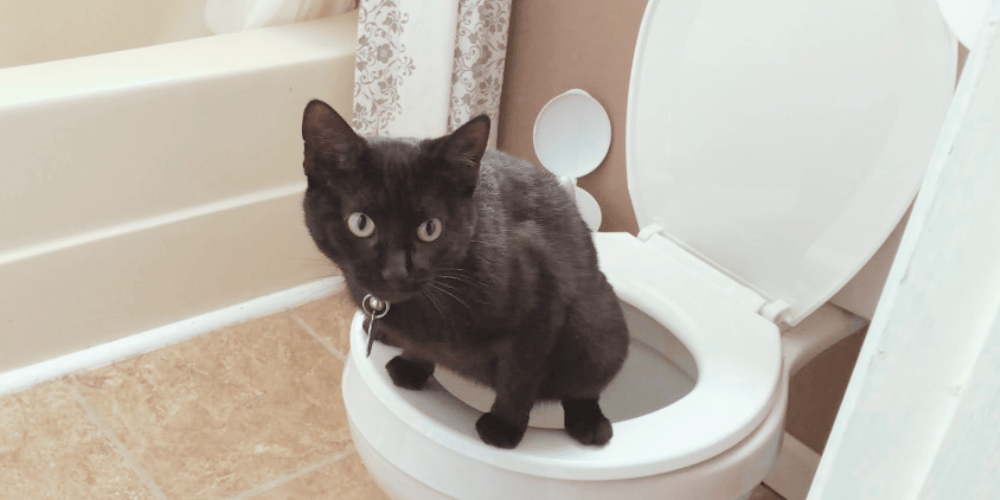
The Evolution of Cat Potty Habits: From Sand to Porcelain Thrones
Let's take a brief walk down memory lane to the origins of cat domestication. Initially, cats were valued for their ability to control pests, and their waste disposal was a natural process that didn't involve humans. Fast forward to modern times, and we're teaching cats to use human toilets. It's a quirky twist in the millennia-long relationship between cats and humans, where convenience meets the ingenuity of cat training. This evolution from sand pits to toilet seats might seem like a small step for a cat, but it's a giant leap in pet management.
However, transitioning from biodegradable litter to the swirling waters of a toilet bowl isn't just a party trick; it reflects a broader shift in how we manage our pets' needs in sync with environmental concerns. By eliminating the need for litter, we reduce landfill waste and minimize the environmental footprint of our feline friends. This shift not only highlights the adaptability of most cats but also underscores the growing trend of eco-conscious pet care practices. As cat ages and our understanding of their impact on the environment evolve, so too do the methods we employ to ensure their habits align with the needs of water-dwelling wildlife and the planet.
When Cats Rule the Bathroom
Ever thought about what happens when your cat achieves full toilet training status? Well, let me paint a picture for you. There's a new bathroom sheriff in town, and it's not any of the human family members. Once cats get the hang of it, many cats love the newfound independence so much that they might just monopolize the bathroom. Imagine the morning queue getting longer because your cat decided it's the perfect time to ponder life's mysteries on the toilet seat.
And what about the nighttime escapades? Cats are naturally nocturnal, so don't be surprised if you're woken up by the sound of the toilet flushing at 3 AM. Yes, some toilet trained cats learn to flush, and while it's environmentally questionable, it's undeniably impressive. Just make sure to keep the bathroom door closed, or you might find your cat hosting late-night bathroom parties with other wildlife, or worse, teaching the dogs the fine art of toilet etiquette.
The Training Process
Training your cat to use the toilet involves patience and persistence. Toilet training kits are available to ease the transition, guiding your cat to gradually adapt to the toilet seat. It's important to go at a pace that's comfortable for your cat to prevent any additional stress or anxiety.
Considerations and Cautions
While the benefits are numerous, toilet training isn't suitable for all cats. Senior cats or those with mobility issues, such as arthritis, may find it difficult to hop onto the toilet seat. Additionally, some behavioral experts suggest that using the toilet goes against a cat's natural instincts to dig and cover their waste, which could potentially lead to stress.
The Verdict
Toilet training a cat can be a rewarding endeavor that leads to a cleaner home and a happier, healthier environment. However, it's not a one-size-fits-all solution. Consider your cat's age, health, and temperament before embarking on this quirky training journey.
Summary
Toilet training cats offers numerous benefits including improved cleanliness, reduced environmental impact, and enhanced health safety. While it may not be suitable for every cat, for many it represents a practical and innovative way to manage pet waste. If you're considering this method, weigh the pros and cons and consider your cat's individual needs to ensure the best outcome.
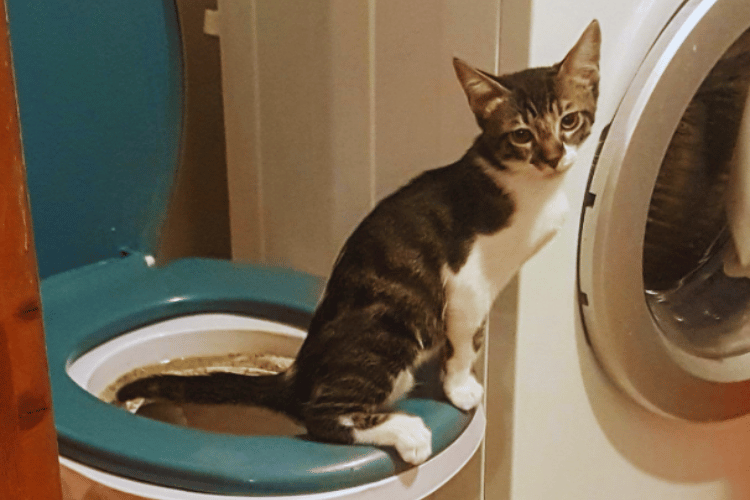
FAQ
Q1: How long does it take to toilet train a cat?
A1: The time it takes to toilet train a cat can vary. Typically, it ranges from a few weeks to several months depending on the cat's adaptability and the consistency of the training.
Q2: Are there any risks associated with toilet training cats?
A2: Yes, there are risks such as the potential for increased stress and the possibility of health issues like bladder inflammation if the cat is not comfortable with the training process.
Q3: Can older cats be toilet trained?
A3: While it's possible to toilet train older cats, it may be more challenging. Older cats with joint issues or other health problems may find it difficult to adapt to using a toilet.
Thank you for visiting LegitLists we hope this helps you make a legitimate choice!






